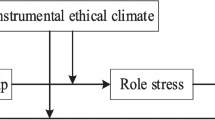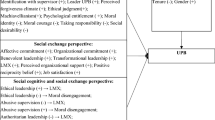Abstract
In this study, we examine the nature of the relationship between ethical leadership and unethical pro-organizational behavior (UPB), defined as unethical behavior conducted by employees with the aim of benefiting their organization, and whether the strength of the relationship differs between subordinates experiencing high and low identification with supervisor. Based on three-wave survey data obtained from 239 public sector employees in China, we find that ethical leadership has an inverted u-shaped (curvilinear) relationship with UPB. As the level of ethical leadership increases from low to moderate, UPB increases; as the level of ethical leadership increases from moderate to high, UPB decreases. Further, we find that the strength of this inverted u-curve relationship differs between subordinates with high and low identification with supervisor. That is to say, the inverted u-shaped relationship between ethical leadership and UPB was stronger when subordinates experienced high levels of identification with supervisor. The theoretical and managerial implications of our findings for understanding how to manage UPB in an organizational context are discussed.


Similar content being viewed by others
References
Aron, A. (2003). Self and close relationships. In M. R. Leary & J. P. Tagney (Eds.), Handbook of self and identity. New York: The Guilford Press.
Ashforth, B. E., Harrison, S. H., & Corley, K. G. (2008). Identification in organizations: An examination of four fundamental questions. Journal of Management, 34, 325–374.
Avey, J. B., Palanski, M. E., & Walumbwa, F. O. (2011). When leadership goes unnoticed: The moderating role of follower self-esteem on the relationship between ethical leadership and follower behavior. Journal of Business Ethics, 98, 573–582.
Bandura, A. (1977). Social learning theory. Englewood Cliffs, NJ: Prentice-Hall.
Bandura, A. (1986). Social foundations of thought and action: A social cognitive theory. Englewood Cliffs, NJ: Prentice-Hall.
Blau, P. M. (1964). Exchange and power in social life. New York: Wiley.
Brewer, M. B., & Gardner, W. (1996). Who is the ‘we’? Levels of collective identity and self representations. Journal of Personality and Social Psychology, 71, 83–93.
Brown, M. E., & Mitchell, M. S. (2010). Ethical and unethical leadership: Exploring new avenues for future research. Business Ethics Quarterly, 20, 583–616.
Brown, M. E., & Treviño, L. K. (2006). Ethical leadership: A review and future directions. Leadership Quarterly, 17, 595–616.
Brown, M. E., Treviño, L. K., & Harrison, D. A. (2005). Ethical leadership: A social learning perspective for construct development and testing. Organizational Behavior and Human Decision Processes, 97, 117–134.
Buchholtz, A. K., & Ribbens, B. A. (1994). Role of chief executive officers in takeover resistance: Effects of CEO incentives and individual characteristics. Academy of Management Journal, 37, 554–579.
Carmeli, A., Atwater, L., & Levi, A. (2011). How leadership enhances employees’ knowledge sharing: The intervening roles of relational and organizational identification. Journal of Technology Transfer, 36, 257–274.
Deshpande, S. P., & Joseph, J. (2009). Impact of emotional intelligence, ethical climate, and behavior of peers on ethical behavior of nurses. Journal of Business Ethics, 85, 403–410.
Detert, J. R., Treviño, L. K., Burris, E. R., & Andiappan, M. (2007). Managerial modes of influence and counterproductivity in organizations: A longitudinal business-unit-level investigation. Journal of Applied Psychology, 92, 993–1005.
Dineen, B. R., Lewicki, R. J., & Tomlinson, E. C. (2006). Supervisory guidance and behavioral integrity: Relationships with employee citizenship and deviant behavior. Journal of Applied Psychology, 91, 622–635.
Dukerich, J. M., Kramer, R., & Parks, J. M. (1998). The dark side of organizational identification. In D. A. Whetten, & P. C. Godfrey (Eds.), Identity in organizations: Building theory through conversations. Thousand Oaks, CA: Sage 245–256.
Erdogan, B., & Liden, R. C. (2002). Social exchanges in the workplace: A review of recent developments and future research directions in leader/member exchange theory. In L. Neider & C. Schriesheim (Eds.), Leadership. Greenwich, CT: Information Age.
Harris, K. J., Kacmar, K. M., & Witt, L. A. (2005). An examination of the curvilinear relationship between leader–member exchange and intent to turnover. Journal of Organizational Behavior, 26, 363–378.
Kacmer, K. M., Bachrach, D. G., Harris, K. J., & Zivnuska, S. (2011). Fostering good citizenship through ethical leadership: Exploring the moderating role of gender and organizational politics. Journal of Applied Psychology, 96, 633–642.
Kaikati, J. G., Sullivan, G. M., Virgo, J. M., Carr, T. R., & Virgo, K. S. (2000). The price of international business morality: Twenty years under the foreign corrupt practices act. Journal of Business Ethics, 26, 213–222.
Kalshoven, K., Den Hartog, D., & De Hoogh, A. H. B. (2011). Ethical leader behavior and big five factors of personality. Journal of Business Ethics, 100, 349–366.
Kark, R., Shamir, B., & Chen, G. (2003). The two faces of transformational leadership: Empowerment and dependence. Journal of Applied Psychology, 88, 246–255.
Lord, R. G., Brown, D. J., & Freiberg, S. J. (1999). Understanding the dynamics of leadership: The role of follower self-concepts in the leader/follower relationship. Organizational Behavior and Human Decision Processes, 78, 167–203.
Mael, F. A., & Ashforth, B. E. (1992). Alumni and their alma mater: A partial test of the reformulated model of organizational identification. Journal of Organizational Behavior, 13, 103–123.
Mayer, D. M., Aquino, K., Greenbaum, R. L., & Kuenzi, M. (2012). Who displays ethical leadership and why does it matter: An examination of antecedents and consequences of ethical leadership. Academy of Management Journal, 55, 151–171.
Mayer, D. M., Kuenzi, M., & Greenbaum, R. L. (2010). Examining the link between ethical leadership and employee misconduct: The mediating role of ethical climate. Journal of Business Ethics, 95, 7–16.
Mayer, D. M., Kuenzi, M., Greenbaum, R. L., Bardes, M., & Salvador, R. (2009). How low does ethical leadership flow? Test of a trickle-down model. Organizational Behavior and Human Decision Processes, 108, 1–13.
Mele, D. (2005). Ethical education in accounting: Integrating rules, values and virtues. Journal of Business Ethics, 57, 97–109.
Mele, D. (2009). Business ethics in action, seeking human excellence in organizations. Basingstoke: Palgrave Macmillan.
Neubert, M. J., Carlson, D. S., Kacmar, K. M., Roberts, J. A., & Chonko, L. B. (2009). The virtuous influence of ethical leadership behavior: Evidence from the field. Journal of Business Ethics, 90, 157–170.
Peterson, D. K. (2004). Perceived leader integrity and ethical intentions of subordinates. The Leadership and Organization Development Journal, 25, 7–23.
Piccolo, R. F., Greenbaum, R., Den Hartog, D. N., & Folger, R. (2010). The relationship between ethical leadership and core job characteristics. Journal of Organizational Behavior 31, 259–278.
Podsakoff, P. M., MacKenzie, S. B., Lee, J. Y., & Podsakoff, N. P. (2003). Common method biases in behavioral research: A critical review of the literature and recommended remedies. Journal of Applied Psychology, 88, 879–903.
Ruiz, P., Ruiz, C., & Martinez, R. (2011). Improving the “leader–follower” relationship: Top manager or supervisor? The ethical leadership trickle-down effect on follower job response. Journal of Business Ethics, 99, 587–608.
Ruiz-Palomino, P., & Martinez-Cañas, R. (2011). Supervisor role modelling ethics related organizational policies and employee ethical intention: The moderating impact of moral ideology. Journal of Business Ethics, 102, 653–668.
Ruiz-Palomino, P., Ruiz-Amaya, C., & Knörr, H. (2011). Employee organizational citizenship behavior: The direct and indirect impact of ethical leadership. Canadian Journal of Administrative Sciences, 28, 244–258.
Shamir, B., Zakay, E., Breinin, E., & Popper, M. (1998). Correlates of charismatic leader behavior in military units: Subordinates’ attitudes, unit characteristics, and superior’s appraisals of leader performance. Academy of Management Journal, 41, 387–409.
Sluss, D. M., & Ashforth, B. E. (2007). Relational identity and identification: Defining ourselves through work relationships. Academy of Management Review, 32, 9–32.
Sluss, D. M., & Ashforth, B. E. (2008). How relational and organizational identification converge: Processes and conditions. Organization Science, 19, 807–823.
Stouten, J., Baillien, E., Van den Broeck, A., Camps, J., De Witte, H., & Euwema, M. (2010). Discouraging bullying: The role of ethical leadership and its effects on the work environment. Journal of Business Ethics, 95, 17–27.
Stouten, J., van Dijke, M., Mayer, D. M., De Cremer, D., & Euwema, M. (2012). Can a leader be too ethical? The curvilinear effects of ethical leadership. Paper presentation at the Academy of Management, Boston, MA.
Tajfel, H. (1982). Social identity and intergroup relations. Cambridge: Cambridge University Press.
Tajfel, H., & Turner, J. C. (1986). The social identity theory of intergroup behavior. In S. Worchel & W. G. Austin (Eds.), Psychology of intergroup relations. Chicago, IL: Nelson-Hall.
Toor, S., & Ofori, G. (2009). Ethical leadership: Examining the relationships with full range leadership model employee outcomes, and organizational culture. Journal of Business Ethics, 90, 533–547.
Treviño, L. K., Brown, M., & Hartman, L. P. (2003). A qualitative investigation of perceived executive ethical leadership: Perceptions from inside and outside the executive suite. Human Relations, 55, 5–37.
Treviño, L. K., Butterfield, K. D., & McCabe, D. M. (1998). The ethical context in organizations: Influences on employee attitudes and behaviors. Business Ethics Quarterly, 8, 447–476.
Treviño, L. K., Hartman, L. P., & Brown, M. (2000). Moral person and moral manager: How executives develop a reputation for ethical leadership. California Management Review, 42, 128–142.
Tumasjan, A., Strobel, M., & Welpe, I. (2011). Ethical leadership evaluations after moral transgression: Social distance makes the difference. Journal of Business Ethics, 99, 609–622.
Umphress, E. E., & Bingham, J. B. (2011). When employees do bad things for good reasons: Examining unethical pro-organizational behaviors. Organization Science, 22, 621–640.
Umphress, E. E., Bingham, J. B., & Mitchell, M. S. (2010). Unethical behavior in the name of the company: The moderating effect of organizational identification and positive reciprocity beliefs influencing unethical pro-organizational behavior. Journal of Applied Psychology, 95, 769–780.
van Knippenberg, D. (2000). Work motivation and performance: A social identity perspective. Applied Psychology: An International Review, 49, 357–371.
van Knippenberg, D., Van Knippenberg, B., Cremer, D. D., & Hogg, M. A. (2004). Leadership, self, and identity: A review and research agenda. Leadership Quarterly, 15, 825–856.
Walumbwa, F. O., Mayer, D. M., Wang, P., Wang, H., Workman, K., & Christensen, A. L. (2011). Linking ethical leadership to employee performance: The roles of leader-member exchange, self-efficacy, and organizational identification. Organizational Behavior and Human Decision Processes, 115, 204–213.
Walumbwa, F. O., & Schaubroeck, J. (2009). Leader personality traits and employee voice behavior: Mediating roles of ethical leadership and work group psychological safety. Journal of Applied Psychology, 94, 1275–1286.
Wang, P., & Rode, J. C. (2010). Transformational leadership and follower creativity: The moderating effects of identification with leader and organizational climate. Human Relations, 63, 1105–1128.
Weismann, M. (2009). The foreign corrupt practices act: The failure of the self-regulatory model of corporate governance in the global business environment. Journal of Business Ethics, 88, 615–661.
Author information
Authors and Affiliations
Corresponding author
Rights and permissions
About this article
Cite this article
Miao, Q., Newman, A., Yu, J. et al. The Relationship Between Ethical Leadership and Unethical Pro-Organizational Behavior: Linear or Curvilinear Effects?. J Bus Ethics 116, 641–653 (2013). https://doi.org/10.1007/s10551-012-1504-2
Received:
Accepted:
Published:
Issue Date:
DOI: https://doi.org/10.1007/s10551-012-1504-2




